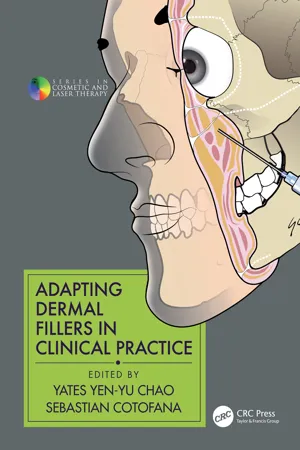
Adapting Dermal Fillers in Clinical Practice
- 274 pages
- English
- ePUB (mobile friendly)
- Available on iOS & Android
Adapting Dermal Fillers in Clinical Practice
About this book
There have been many different brands of dermal fillers approved for use for soft tissue augmentation in the US market alone, comprising four different types of temporary fillers and one permanent type, with several other brands and types also available elsewhere in the world. Against such a potentially bewildering variety and range of choices, this new text offers a scientific and an anatomic rationale for why a particular filler should be selected as optimal for each individual location and indication and how it should best be used in treatments. International experts share their clinical knowledge and expertise to guide all levels of aesthetic practitioners toward the best results for each individual patient.
CONTENTS: Fundamentals of Injectable Filler Procedures * Basic Injection Techniques * Modified and Advanced Injection Techniques * Novel Injection Techniques * Aesthetic Filler Injection Pearls * Adapting Injection Techniques to Different Regions * Adapting Injection Techniques to Special Indications * Adapting Injection Techniques to Different Filling Materials * Adapting Injection Techniques to Different Genders * Adapting Injection Techniques to Different Age Groups * Adapting Injection Techniques to Patients of Different Ethnicity * Prevention and Management of Complications.
Frequently asked questions
- Essential is ideal for learners and professionals who enjoy exploring a wide range of subjects. Access the Essential Library with 800,000+ trusted titles and best-sellers across business, personal growth, and the humanities. Includes unlimited reading time and Standard Read Aloud voice.
- Complete: Perfect for advanced learners and researchers needing full, unrestricted access. Unlock 1.4M+ books across hundreds of subjects, including academic and specialized titles. The Complete Plan also includes advanced features like Premium Read Aloud and Research Assistant.
Please note we cannot support devices running on iOS 13 and Android 7 or earlier. Learn more about using the app.
Information
1Fundamentals of Injectable Filler Procedures
- 1.1 Introduction
- 1.2 Preparation of Fillers
- 1.2.1 Temperature
- 1.2.2 Dilution and Additives
- 1.2.3 Repackaging
- 1.2.4 Needles and Cannula
- 1.3 Preparation of Patients
- 1.3.1 Cleansing
- 1.3.2 Pain Control
- 1.3.3 Marking
- 1.3.4 Positioning
- 1.4 During the Procedure
- 1.4.1 Illumination
- 1.4.2 Antiseptics
- 1.4.3 Bleeding Control
- 1.4.4 Assistants
- 1.5 Aftercare
- 1.5.1 Pain Control
- 1.5.2 Skincare
- 1.5.3 Medications
- 1.5.4 Massages and Molding
- 1.5.5 Follow-Up
- 1.6 Touch-Up and Refill
- 1.7 Ultrasound Imaging
- Bibliography
1.1 INTRODUCTION

1.2 PREPARATION OF FILLERS
1.2.1 Temperature
1.2.2 Dilution and Additives

Table of contents
- Cover Page
- Half-Title Page
- Series Page
- Title Page
- Copyright Page
- Contents
- Preface
- 1 Fundamentals of Injectable Filler Procedures
- 2 Basic Injection Techniques
- 3 Modified and Advanced Injection Techniques
- 4 Novel Injection Techniques
- 5 Esthetic Filler Injection Pearls
- 6 Adapting Injection Techniques to Different Regions
- 7 Adapting Injection Techniques to Special Indications
- 8 Adapting Injection Techniques to Different Filling Materials
- 9 Adapting Injection Techniques to Different Genders
- 10 Adapting Injection Techniques to Different Age Groups
- 11A Adapting Injection Techniques to Patients of Different Ethnicity
- 11B Adapting Injection Techniques to Patients of Different Ethnicity
- 11C Adapting Injection Techniques to Patients of Different Ethnicity
- 12 Prevention and Management of Complications
- Index